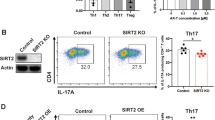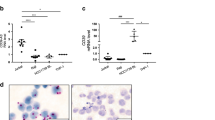Abstract
A common mutation in the gene encoding the cytoplasmic sensor Nod2, involving a frameshift insertion at nucleotide 3020 (3020insC), is strongly associated with Crohn's disease. How 3020insC contributes to this disease is a controversial issue. Clinical studies have identified defective production of interleukin 10 (IL-10) in patients with Crohn's disease who bear the 3020insC mutation, which suggests that 3020insC may be a loss-of-function mutation. However, here we found that 3020insC Nod2 mutant protein actively inhibited IL10 transcription. The 3020insC Nod2 mutant suppressed IL10 transcription by blocking phosphorylation of the nuclear ribonucleoprotein hnRNP-A1 via the mitogen-activated protein kinase p38. We confirmed impairment in phosphorylation of hnRNP-A1 and binding of hnRNP-A1 to the IL10 locus in peripheral blood mononuclear cells from patients with Crohn's disease who bear the 3020insC mutation and have lower production of IL-10.
This is a preview of subscription content, access via your institution
Access options
Subscribe to this journal
Receive 12 print issues and online access
$209.00 per year
only $17.42 per issue
Buy this article
- Purchase on Springer Link
- Instant access to full article PDF
Prices may be subject to local taxes which are calculated during checkout








Similar content being viewed by others
References
Podolsky, D.K. Inflammatory bowel disease. N. Engl. J. Med. 347, 417–429 (2002).
Fuss, I.J., Boirivant, M., Lacy, B. & Strober, W. The interrelated roles of TGF-β and IL-10 in the regulation of experimental colitis. J. Immunol. 168, 900–908 (2002).
Inohara, N. & Nunez, G. NODs: intracellular proteins involved in inflammation and apoptosis. Nat. Rev. Immunol. 3, 371–382 (2003).
Girardin, S.E. et al. Nod1 detects a unique muropeptide from gram-negative bacterial peptidoglycan. Science 300, 1584–1587 (2003).
Girardin, S.E. et al. Nod2 is a general sensor of peptidoglycan through muramyl dipeptide (MDP) detection. J. Biol. Chem. 278, 8869–8872 (2003).
Ogura, Y. et al. Nod2, a Nod1/Apaf-1 family member that is restricted to monocytes and activates NF-κB. J. Biol. Chem. 276, 4812–4818 (2001).
Abbott, D.W., Wilkins, A., Asara, J.M. & Cantley, L.C. The Crohn's disease protein, NOD2, requires RIP2 in order to induce ubiquitinylation of a novel site on NEMO. Curr. Biol. 14, 2217–2227 (2004).
Inohara, N. et al. An induced proximity model for NF-κB activation in the Nod1/RICK and RIP signaling pathways. J. Biol. Chem. 275, 27823–27831 (2000).
Hugot, J.P. et al. Association of NOD2 leucine-rich repeat variants with susceptibility to Crohn's disease. Nature 411, 599–603 (2001).
Lesage, S. et al. CARD15/NOD2 mutational analysis and genotype-phenotype correlation in 612 patients with inflammatory bowel disease. Am. J. Hum. Genet. 70, 845–857 (2002).
Ogura, Y. et al. A frameshift mutation in NOD2 associated with susceptibility to Crohn's disease. Nature 411, 603–606 (2001).
Seiderer, J. et al. Predictive value of the CARD15 variant 1007fs for the diagnosis of intestinal stenoses and the need for surgery in Crohn's disease in clinical practice: results of a prospective study. Inflamm. Bowel Dis. 12, 1114–1121 (2006).
Kuhn, R., Lohler, J., Rennick, D., Rajewsky, K. & Muller, W. Interleukin-10-deficient mice develop chronic enterocolitis. Cell 75, 263–274 (1993).
Davidson, N.J. et al. T helper cell 1-type CD4+ T cells, but not B cells, mediate colitis in interleukin 10-deficient mice. J. Exp. Med. 184, 241–251 (1996).
Sellon, R.K. et al. Resident enteric bacteria are necessary for development of spontaneous colitis and immune system activation in interleukin-10-deficient mice. Infect. Immun. 66, 5224–5231 (1998).
Kullberg, M.C. et al. Helicobacter hepaticus triggers colitis in specific-pathogen-free interleukin-10 (IL-10)-deficient mice through an IL-12- and γ interferon-dependent mechanism. Infect. Immun. 66, 5157–5166 (1998).
Netea, M.G. et al. NOD2 mediates anti-inflammatory signals induced by TLR2 ligands: implications for Crohn's disease. Eur. J. Immunol. 34, 2052–2059 (2004).
Maeda, S. et al. Nod2 mutation in Crohn's disease potentiates NF-κB activity and IL-1β processing. Science 307, 734–738 (2005).
Pauleau, A.L. & Murray, P.J. Role of nod2 in the response of macrophages to toll-like receptor agonists. Mol. Cell. Biol. 23, 7531–7539 (2003).
Netea, M.G. et al. Nucleotide-binding oligomerization domain-2 modulates specific TLR pathways for the induction of cytokine release. J. Immunol. 174, 6518–6523 (2005).
Cao, S., Liu, J., Song, L. & Ma, X. The protooncogene c-Maf is an essential transcription factor for IL-10 gene expression in macrophages. J. Immunol. 174, 3484–3492 (2005).
Steiner, G., Skriner, K., Hassfeld, W. & Smolen, J.S. Clinical and immunological aspects of autoantibodies to RA33/hnRNP-A/B proteins–a link between RA, SLE and MCTD. Mol. Biol. Rep. 23, 167–171 (1996).
Caporali, R., Bugatti, S., Bruschi, E., Cavagna, L. & Montecucco, C. Autoantibodies to heterogeneous nuclear ribonucleoproteins. Autoimmunity 38, 25–32 (2005).
Jones, D.A. et al. Identification of autoantigens in psoriatic plaques using expression cloning. J. Invest. Dermatol. 123, 93–100 (2004).
Netea, M.G. et al. NOD2 3020insC mutation and the pathogenesis of Crohn's disease: impaired IL-1β production points to a loss-of-function phenotype. Neth. J. Med. 63, 305–308 (2005).
Brockstedt, E. et al. Identification of apoptosis-associated proteins in a human Burkitt lymphoma cell line. Cleavage of heterogeneous nuclear ribonucleoprotein A1 by caspase 3. J. Biol. Chem. 273, 28057–28064 (1998).
Kim, C. et al. The kinase p38α serves cell type-specific inflammatory functions in skin injury and coordinates pro- and anti-inflammatory gene expression. Nat. Immunol. 9, 1019–1027 (2008).
Buxade, M. et al. The Mnks are novel components in the control of TNF α biosynthesis and phosphorylate and regulate hnRNP A1. Immunity 23, 177–189 (2005).
Linde, K. et al. Card15 and Crohn's disease: healthy homozygous carriers of the 3020insC frameshift mutation. Am. J. Gastroenterol. 98, 613–617 (2003).
Yamazaki, K., Takazoe, M., Tanaka, T., Kazumori, T. & Nakamura, Y. Absence of mutation in the NOD2/CARD15 gene among 483 Japanese patients with Crohn's disease. J. Hum. Genet. 47, 469–472 (2002).
Wehkamp, J. et al. NOD2 (CARD15) mutations in Crohn's disease are associated with diminished mucosal α-defensin expression. Gut 53, 1658–1664 (2004).
Kramer, M., Netea, M.G., de Jong, D.J., Kullberg, B.J. & Adema, G.J. Impaired dendritic cell function in Crohn's disease patients with NOD2 3020insC mutation. J. Leukoc. Biol. 79, 860–866 (2006).
van Heel, D.A. et al. Muramyl dipeptide and toll-like receptor sensitivity in NOD2-associated Crohn's disease. Lancet 365, 1794–1796 (2005).
Holler, E. et al. Both donor and recipient NOD2/CARD15 mutations associate with transplant-related mortality and GvHD following allogeneic stem cell transplantation. Blood 104, 889–894 (2004).
Watanabe, T., Kitani, A., Murray, P.J. & Strober, W. NOD2 is a negative regulator of Toll-like receptor 2–mediated T helper type 1 responses. Nat. Immunol. 5, 800–808 (2004).
Liu, J., Cao, S., Herman, L.M. & Ma, X. Differential regulation of interleukin (IL)-12 p35 and p40 gene expression and interferon (IFN)-γ-primed IL-12 production by IFN regulatory factor 1. J. Exp. Med. 198, 1265–1276 (2003).
Netea, M.G. et al. NOD2 mediates induction of the antiinflammatory signals induced by TLR2-ligands: implications for Crohn's disease. Eur. J. Immunol. 34, 2052–2059 (2004).
Acknowledgements
We thank P.J. Murray (St. Jude Children's Research Hospital) for Nod2-knockout and control littermate mice; E. Pamer (Memorial Sloan-Kettering Cancer Center) for RICK-knockout (RIP2-knockout) and control mice; J.M. Park (Harvard University School of Medicine) for mice with conditional knockout of p38α; and G. Nunez (University of Michigan) for the mouse Nod2 expression vector and mouse 2939insC Nod2. Supported by the Broad Medical Research Program (IBD-210R2 to X.M.).
Supplementary information
Supplementary Text and Figures
Supplementary Figures 1–3, Supplementary Table 1 and Supplementary Methods (PDF 708 kb)
Rights and permissions
About this article
Cite this article
Noguchi, E., Homma, Y., Kang, X. et al. A Crohn's disease–associated NOD2 mutation suppresses transcription of human IL10 by inhibiting activity of the nuclear ribonucleoprotein hnRNP-A1. Nat Immunol 10, 471–479 (2009). https://doi.org/10.1038/ni.1722
Received:
Accepted:
Published:
Issue Date:
DOI: https://doi.org/10.1038/ni.1722
This article is cited by
-
Frequent Occurrence of Perianal Disease and Granuloma Formation in Patients with Crohn’s Disease and Coexistent Orofacial Granulomatosis
Digestive Diseases and Sciences (2023)
-
Intestinal Barrier Dysfunction in Inflammatory Bowel Disease: Underpinning Pathogenesis and Therapeutics
Digestive Diseases and Sciences (2023)
-
Inflammatory Bowel Disease: Pathophysiology, Treatment, and Disease Modeling
BioChip Journal (2023)
-
Immunologic and Genetic Contributors to CD46-Dependent Immune Dysregulation
Journal of Clinical Immunology (2023)
-
Severity of local inflammation does not impact development of fibrosis in mouse models of intestinal fibrosis
Scientific Reports (2018)



